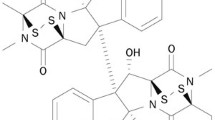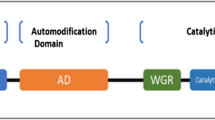Abstract
To investigate the role of poly(ADP-ribose)polymerase (PARP) in the physiological condition of cell growth, we studied the ability of PARP inhibitors to induce apoptosis. Benzamide (BA) and 4-amino-1,8-naphthalimide (NAP), two well-known inhibitors of PARP, treatment increased nuclear fragmentation and caspase-3 activity in HeLa (Human cervical cancer cell line) cells. The increase of cellular NAD+ level was observed in HeLa cells treated with BA in comparison with untreated control cells. For unrevealing the specific PARP family member responsible for such induction of apoptosis we knocked down and over-expressed PARP-1 gene in HeLa cells. PARP-1 knock down cells were sensitive to BA induced nuclear fragmentation and caspase-3 activation while exogenous expression of PARP-1 rendered cells resistant to BA induced apoptosis. This result indicated that inhibition of PARP-1 resulted in induction of apoptosis.








Similar content being viewed by others
Abbreviations
- PAR:
-
Poly(ADP-ribose)
- PARP:
-
Poly(ADP-ribose)polymerase
- AIF:
-
Apoptosis inducing factor
- NAD:
-
Nicotinamide adenine dinucleotide
References
D’Amours D, Denoyers S, D’Silva I et al (1999) Poly(ADP-ribosyl)ation reactions in the regulation of nuclear functions. Biochem J 342:249–268. doi:10.1042/0264-6021:3420249
Cleaver JE, Morgan WF (1991) Poly(ADP-ribose)polymerase: a perplexing participant in cellular responses to DNA breakage. Mutat Res 257:1–18
Virag L, Szabo C (2002) The therapeutic potential of poly(ADP-ribose)polymerase inhibitors. Pharmacol Rev 54:375–429. doi:10.1124/pr.54.3.375
Tentori L, Portarena I, Graziani G (2002) Potential clinical applications of poly(ADP-ribose)polymerase (PARP) inhibitors. Pharmacol Res 45:73–85. doi:10.1006/phrs.2001.0935
Chalmers AJ (2004) Poly(ADP-ribose)polymerase-1 and inonizing radiation: sensor, signaling and therapeutic target. Clin Oncol 16:29–39. doi:10.1016/S0936-6555(03)00223-1
Nicholson DW, Ali A, Thornberry NA et al (1995) Identification and inhibition of the ICE/CED-3 protease necessary for mammalian apoptosis. Nature 376:37–43. doi:10.1038/376037a0
Oliver FJ, de la Rubia G, Rolli V et al (1998) Importance of poly(ADP-ribose)polymerase and its cleavage in apoptosis Lesson from an uncleavable mutant. J Biol Chem 273:33533–33539. doi:10.1074/jbc.273.50.33533
Yakovlev AG, Wang G, Stoica BA et al (1999) Role of DNAS1L3 in Ca++ Mg++-dependent cleavage of DNA into oligonucleosomal and high molecular mass fragments. Nucleic Acids Res 27:1999–2005. doi:10.1093/nar/27.9.1999
Yakovlev AG, Wang G, Stoica BA et al (2000) A role of the Ca2+/Mg2+-dependent endonuclease in apoptosis and its inhibition by Poly(ADP-ribose)polymerase. J Biol Chem 275:21302–21308. doi:10.1074/jbc.M001087200
Pleschke JM, Kleczkowska HE, Strohm M et al (2000) Poly(ADP-ribose) binds to specific domains in DNA damage checkpoint proteins. J Biol Chem 275:40974–40980. doi:10.1074/jbc.M006520200
West JD, Ji C, Marnett LJ (2005) Modulation of DNA fragmentation factor 40 nuclease activity by poly(ADP-ribose)polymerase-1. J Biol Chem 280:15141–15147. doi:10.1074/jbc.M413147200
Czapski GA, Cakala M, Kopczuk D et al (2004) Effect of poly(ADP-ribose)polymerase inhibitors on oxidative stress evoked hydroxyl radical level and macromolecules oxidation in cell free system of rat brain cortex. Neurosci Lett 356:45–48. doi:10.1016/j.neulet.2003.11.022
Kuo ML, Shen SC, Yang CH et al (1998) Bcl-2 prevents topoisomerase II inhibitor GL331-induced apoptosis is mediated by down regulation of poly(ADP-ribose)polymerase activity. Oncogene 17:2225–2234. doi:10.1038/sj.onc.1202133
Pacini A, Quattrone A, Denegri M et al (1999) Transcriptional down-regulation of poly(ADP-ribose)polymerase gene expression by E1A binding to pRb proteins protects murine keratinocytes from radiation-induced apoptosis. J Biol Chem 274:35107–35112. doi:10.1074/jbc.274.49.35107
Richardson DS, Allen PD, Kelsey SM et al (1999) Effects of PARP inhibition on drug and Fas-induced apoptosis in leukaemic cells. Adv Exp Med Biol 457:267–279
Pettitt AR, Sherrington PD, Cawley JC et al (2000) Role of poly(ADP-ribosyl)ation in the killing of chronic lymphocytic leukemia cells by purine analogues. Cancer Res 60:4187–4193
Ghosh U, Pandit B, Dutta J et al (2004) Induction of apoptosis by benzamide and its inhibition by aurin tricarboxylic acid(ATA) in Chinese hamster V79 cells. Mutat Res 554:121–129. doi:10.1016/j.mrfmmm.2004.04.002
Tentori L, Orlando L, Lacal PM et al (1997) Inhibition of O6-alkylguanine DNA-alkyltransferase or poly(ADP-ribose)polymerase increases susceptibility of leukemic cells to apoptosis induced by temozolomide. Mol Pharmacol 52:249–258
Walisser JA, Thies RL (1999) Poly(ADP-ribose)polymerase inhibition in oxidant-stressed endothelial cells prevents oncosis and permits caspase activation and apoptosis. Exp Cell Res 251:401–413. doi:10.1006/excr.1999.4589
Munoz-Gamez JA, Martin-Oliva D, Aguilar-Quesada R et al (2005) PARP inhibition sensitizes p53-deficient breast cancer cells to doxorubicin-induced apoptosis. Biochem J 386:119–125. doi:10.1042/BJ20040776
de Murcia JM, Ricoul M, Tartier L (2003) Functional interaction between PARP-1 and PARP-2 in chromosome stability and embryonic development in mouse. EMBO J 22:2255–2263. doi:10.1093/emboj/cdg206
de Murcia JM, Niedergang C, Trucco C et al (1997) Requirement of poly(ADP-ribose)polymerase in recovery from DNA damage in mice and in cells. Proc Natl Acad Sci USA 94:7303–7307. doi:10.1073/pnas.94.14.7303
Farmer H, McCabe N, Lord CJ et al (2005) Targeting the DNA repair defect in BRCA mutant cells as a therapeutic strategy. Nature 434:917–921. doi:10.1038/nature03445
Bryant HE, Schultz N, Thomas HD et al (2005) Specific killing of BRCA-2-deficient tumours with inhibitors of poly(ADP-ribose)polymerase. Nature 434:913–917. doi:10.1038/nature03443
Nguewa PA, Fuertes MA, Cepeda V et al (2006) Poly(ADP-ribose)polymerase-1 inhibitor 3-aminobenzamide enhances apoptosis induction by platinum complexes in cisplatin-resistant tumor cells. Med Chem 2(1):47–53. doi:10.2174/157340606775197697
Diaz-Hernandez JI, Moncada S, Bolan JP et al (2007) Poly(ADP-ribose)polymerase-1 protects neurons against apoptosis induced by oxidative stress. Cell Death Differ 14:1211–1221. doi:10.1038/sj.cdd.4402117
Plummer ER (2006) Inhibition of poly(ADP-ribose)polymerase in cancer. Curr Opin Pharmacol 6:364–368. doi:10.1016/j.coph.2006.02.004
Ghosh U, Das N, Bhattacharyya NP (2007) Inhibition of telomerase activity by reduction of poly(ADP-ribosyl)ation of TERT and TEP1/TP1 expression in HeLa cells with knocked down poly(ADP-ribose)polymerase-1 (PARP-1) gene. Mutat Res 615(1–2):66–74. doi:10.1016/j.mrfmmm.2006.10.002
Ghosh U, Bhattacharyya NP (2005) Benzamide and 4-amino-1,8-naphthalimide treatment inhibit telomerase activity by down-regulating the expression of telomerase associated protein and inhibiting the poly(ADP-ribosyl)ation of telomerase reverse transcriptase in cultured cells. FEBS J 272:4237–4248. doi:10.1111/j.1742-4658.2005.04837.x
Ying W, Garnier P, Swanson RA (2003) NAD+ repletion prevents PARP-1-induced glycolytic blockade and cell death in cultured mouse astrocytes. BBRC 308:809–813
Radons J, Heller B, Burkle A et al (1994) Nitric oxide toxicity in islet cells involves poly(ADP-ribose)polymerase activation and concomitant NAD+ depletion. BBRC 199:1270–1277
Banasik M, Komura H, Shimoyama M et al (1992) Specific inhibitors of poly(ADP-ribose) synthetase and mono(ADP-ribosyl) transferase. J Biol Chem 267:1569–1575
Kun E, Kirsten E, Milo GE et al (1983) Cell cycle-dependent intervention by benzamide of carcinogen-induced neoplastic transformation and in vitro poly(ADP-ribosyl)ation of nuclear proteins in human fibroblasts. Proc Natl Acad Sci USA 80(23):7219–7223. doi:10.1073/pnas.80.23.7219
Cregan SP, Fortin A, MacLaurin JG et al (2002) Apoptosis-inducing factor is involved in the regulation of caspase-independent neuronal cell death. J Cell Biol 158:507–517. doi:10.1083/jcb.200202130
Yu SW, Wang H, Poitras MF et al (2002) Mediation of poly(ADP-ribose)polymerase-1-dependent cell death by apoptosis-inducing factor. Science 297:259–263. doi:10.1126/science.1072221
Xu Y, Huang S, Liu ZG et al (2006) Poly(ADP-ribose)polymerase-1 signaling to mitochondria in necrotic cell death requires RIP1/TRAF2-mediated JNK1 activation. J Biol Chem 281:8788–8795. doi:10.1074/jbc.M508135200
Koh DW, Dawson TM, Dawson VL (2005) Mediation of cell death by poly(ADP-ribose)polymerase-1. Pharmacol Res 52:5–14. doi:10.1016/j.phrs.2005.02.011
Andrabi SA, Kim NS, Yu SW et al (2006) Poly(ADP-ribose) (PAR) polymer is a death signal. Proc Natl Acad Sci USA 103:18308–18313. doi:10.1073/pnas.0606526103
Saldeen J, Welsh N (1998) Nicotinamide-induced apoptosis in insulin producing cells is associated with cleavage of poly(ADP-ribose)polymerase. Mol Cell Endocrinol 139:99–107. doi:10.1016/S0303-7207(98)00068-9
Ogata S, Takeuchi M, Fujita H et al (2000) Apoptosis induced by nicotinamide- related compounds and quinolinic acid in HL-60 cells. Biosci Biotechnol Biochem 64:327–332. doi:10.1271/bbb.64.327
Yang J, Liu X, Bhalla K et al (1997) Prevention of apoptosis by Bcl-2: release of cytochrome c from mitochondria blocked. Science 275:1129–1132. doi:10.1126/science.275.5303.1129
Liu X, Kim CN, Yang J et al (1996) Induction of apoptotic program in cell-free extracts: requirement for dATP and cytochrome c. Cell 86:147–157. doi:10.1016/S0092-8674(00)80085-9
Susin SA, Lorenzo HK, Zamzami N et al (1999) Molecular characterization of mitochondrial apoptosis-inducing factor. Nature 397:441–446. doi:10.1038/17135
Chen M, Zsengeller Z, Xiao C et al (2004) Mitochondrial-to-nuclear translocation of apoptosis-inducing factor in cardiac myocytes during oxidant stress: potential role of poly(ADP-ribose)polymerase-1. Cardiovasc Res 63:682–688. doi:10.1016/j.cardiores.2004.04.018
Lassus P, Opitz-Araya X, Lazebnik Y (2002) Requirement for caspase-2 in stress-induced apoptosis before mitochondrial permeabilization. Science 297:1352–1354. doi:10.1126/science.1074721
Guo Y, Srinivasula SM, Druilhe A et al (2002) Caspase-2 induces apoptosis by releasing proapoptotic proteins from mitochondria. J Biol Chem 277:13430–13437. doi:10.1074/jbc.M108029200
Acknowledgement
We are also thankful to Dr. G. G. Poirier, Health and Environment Unit, Laval University Medical Research Center, CHUQ, Faculty of Medicine, Laval University, 2705, Boulevard Laurier, Ste-Foy, Québec, G1 V 4G2, Canada for providing the plasmid pCMV-Tag 2B.
Author information
Authors and Affiliations
Corresponding author
Electronic supplementary material
Below is the link to the electronic supplementary material.
Rights and permissions
About this article
Cite this article
Ghosh, U., Bhattacharyya, N.P. Induction of apoptosis by the inhibitors of poly(ADP-ribose)polymerase in HeLa cells. Mol Cell Biochem 320, 15–23 (2009). https://doi.org/10.1007/s11010-008-9894-2
Received:
Accepted:
Published:
Issue Date:
DOI: https://doi.org/10.1007/s11010-008-9894-2




